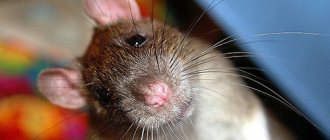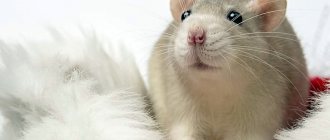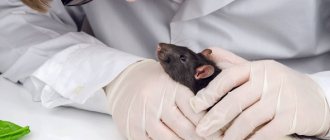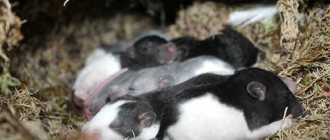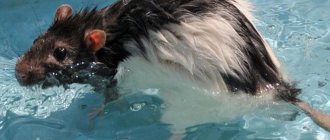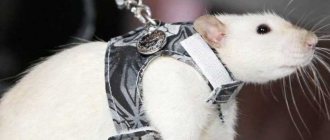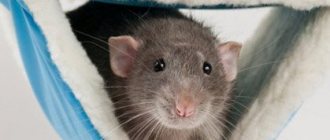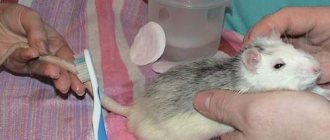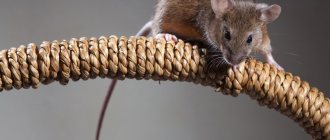A veterinarian must diagnose the disease, identify the cause and treat the furry friend; the owner can provide first aid to his beloved pet and immediately deliver the animal to the clinic. Owners of decorative rats often have questions about what actions need to be taken when characteristic symptoms of various diseases appear; in this article we will try to answer some of them.
How to give an injection to a rat
Giving an injection to a rat is absolutely not difficult, the main thing is to be confident in your abilities so that your hands do not tremble during the injection. It is necessary to inject rodents with insulin syringes, which rats perceive almost painlessly.
At home, the owner can carry out subcutaneous and intramuscular injections; intravenous administration of medications should be done by specialists.
To administer the medicine subcutaneously, you need to pull back the skin fold with two fingers, most often in the withers area, inject the syringe parallel to the ridge and inject the solution.
When performing an intramuscular injection, the animal must be turned with its muzzle towards you, fix the abdomen and thigh with your fingers, pull back the paw and inject the syringe. It is better to give injections to fidgety animals with an assistant.
Husky rat colors
At birth, Husky rat pups can have the following colors: red, gray, black, blue. Moreover, babies’ fur is very soft and pleasant to the touch. Over time, the characteristic pattern on the animal’s body and face may change. Now there are 2 types of color for representatives of this breed:
- Raincoat. The fur is colored on the face, with the exception of the mask (blaze), and completely on the back, while the belly remains white.
- By type of hood. The upper part of the body is painted - the head, shoulder girdle and chest. Colored fur also grows along the spine.
Many breeders of ornamental rodents note that by the end of their life, a husky rat can turn completely white. What the mechanisms of constant color change are related to is currently not established.
What to do if a rat chokes
You can understand that a rat is choking by the behavior of a domestic rodent: the animal is trying to swallow something, profuse salivation appears, sometimes with foam, the pet lies motionless, hides, lowers its head down, and convulsions may be present. In such a situation, it is urgent to save the pet; rats do not have a gag reflex, and the rodent may suffocate.
The owner needs to inject 0.1 ml of dexamethasone into the withers, then use a cotton swab to clean the oral cavity of food debris, then gently shake the animal several times, firmly holding the rat head down. These manipulations should help the rat spit out or swallow the stuck food; after an attack, it is not recommended to feed the animal with rough dry food for 24 hours. In the near future, it is advisable to show your little friend to a specialist; healthy animals should not choke on food; perhaps the pet rat needs treatment.
The only tricolor beauty
The second tricolor rat was born in 2006 and received the original name - Dusty Mouse Shabu-Shabu. This is an amazing baby that violates all previously formed concepts about the genetics of rodents. Its uniqueness lies in the fact that the wool is dyed in three colors. According to the marking standard, this animal has a champagne hood color. The tri-colored Shabu-Shabu rat has a champagne-colored stripe along its back, head and shoulders, and the rest of the body is white. But in addition to these colors, black spots are also visible on this original. Theoretically, this is considered impossible.
More than 40 types of markings and colors are known to professionals involved in breeding and keeping rats.
However, there is not a single individual that combines exactly three colors. Shabu-Shabu Dust Mouse's parents were champagne and black hoods. Nothing similar was observed in other litters of these parents.
Recently, rare white rats with red eyes have been observed. These are albinos. This white color and eye color indicate that they have problems with melanin production.
What to do if a rat falls from a height
Decorative rats often fall from heights due to the carelessness of their owners; such cases are fraught with bruises, fractures, internal bleeding, and strokes. If your rat has fallen from a height, it is advisable to inject it with 0.1 ml of prednisolone into the withers and drink 0.5 ml of children's painkiller syrup Nurofen from an insulin syringe without a needle. After the injections, it is necessary to examine the animal, check the integrity of the bones and skin, and the absence of bleeding. It is advisable for your pet to create a darkened, calm atmosphere, add vitamins for rats to the diet, and within a few days the animal should recover from shock.
If there are fractures, bleeding, or lack of coordination, the furry rodent must be urgently taken to a veterinary clinic; the animal will need radiography to determine the nature of the damage.
Pets
Professionals know a considerable number of colors of rats. All of them in most cases appear in the form of various color combinations. Meanwhile, not all rodents meet the requirements of the standard. Nevertheless, owners of such rats can register them in the prescribed form and present them as an independent breed.
The most important thing is to focus on a limited number of relevant features. Worried about the color and color of the eyes, breeders often neglect to take care of the physique and well-being of the animal. As a result, many purebred rats, unlike wild rodents, are characterized by poor health and reduced vitality.
Every pet can be identified by color, markings and coat type. Some rat color names were taken from other representatives of the animal world, namely cats and dogs. For example: Siamese, Rex, Husky. Currently, the colors of rats are often found in completely different shades, which can be red, black, or silver. Siamese and Himalayan animals are found in large numbers.
What to do if a rat breaks its leg
Pet rats sometimes break fragile limb bones. When a fracture occurs, the animal's paw turns blue, swells, may be unnaturally twisted or hanging, and an increase in local temperature is observed.
Limb fractures in rats heal relatively easily; the pet must be moved to a small cage without floors to reduce mobility.
Before visiting a specialist, the rodent can be injected with meloxicam 0.02 ml from an insulin syringe and the damaged limb can be smeared with Traumeel anti-inflammatory gel 2 times a day. It is recommended to take the animal to a veterinary clinic for splinting and appointment. Within 2-3 weeks, the swelling subsides and the fracture heals safely.
How much does a husky rat cost?
With all the advantages of husky rats, a pet of this breed can be bought at an inexpensive price. In the pet store and at the bird market, the cost per fluffy fluctuates between 200-500 rubles. Professional breeders sell baby rats for 500-1000 rubles.
However, some animals are especially valued, for example, for a husky rat with eyes of different colors you will have to pay at least 2,000 rubles.
The Husky rat is an excellent choice for those who want to buy a beautiful and easy-to-care pet. In addition, an easygoing fluffy with a kind character will become a true friend for his owner, and will delight him every day with devotion and unconditional love.
What to do if a rat has blood in its urine
If a domestic rat urinates in blood, this indicates pathologies of the genitourinary system as a result of hypothermia or diseases of the urinary tract. Rodents are susceptible to cystitis, kidney failure, urolithiasis, polyps and neoplasms of the kidneys and bladder.
The animal requires an examination by a specialist, an x-ray examination for bladder stones and a laboratory examination of a urine sample, which must be collected in a sterile syringe and delivered to a veterinary clinic within three hours. Depending on the diagnosis, the rodent is prescribed surgery to remove stones and a course of antibacterial, diuretic and anti-inflammatory drugs.
Features in the content
It is necessary to constantly clean the cage, as well as regularly update the sawdust. The rodent needs your attention and care; if you don’t have time for this, then you can put a wheel in the cage. If the rodent's cage is very large, then you can install a small pool in it. Some rodents love to spend time in water, but you should change the water every day, otherwise your rat may get sick and the cage will start to smell bad.
A husky rat's diet should include healthy treats.
Typically, Husky rats eat standard grain food, which can be purchased at pet stores. But they are also not averse to eating regular food, such as apples, bananas and pears, the main thing is to observe moderation and not give them junk food. You should also buy a variety of teeth sharpeners.
What to do if your rat hiccups frequently
A decorative rat hiccups due to hypothermia, overeating, overexcitation, and helminthic infestation. If the animal occasionally hiccups, there is no need to worry; it is necessary to reconsider the diet and living conditions of the furry rodent; it would not be superfluous to carry out preventive deworming.
In the case of frequent hiccups accompanied by grunting, whistling, wheezing, and heavy breathing, the development of pneumonia in a pet can be suspected. In this case, hiccups accompany attacks of suffocation in the rat; the small animal must be urgently taken to a veterinary clinic. Inflammation of the lungs in decorative rats develops rapidly and can cause the death of the pet; to treat the disease, the animal is prescribed a course of antibacterial, hormonal, anti-inflammatory and vitamin preparations.
Division of colors
Color is the color or shade of the fur of a decorative rat. Currently, there is a fairly large number of shades, and they are all divided into uniform, ticked and combined, silver and marked:
- Uniform colors are when all the hairs are the same color and tone. For example, black - the coat is black from root to tip. The undercoat is extremely dark. There may be other colors - blue, Russian blue, smoky blue.
- Ticked colors. Ticking is uneven hair coloring. In other words, there are zones on the wool that are colored in different colors. Among these non-standardly colored hairs, guard hairs of the same tone are identically interspersed. Agouti-colored rats are ticked.
- Silver color is absolutely any of the generally recognized colors. They can be uniform and ticked. Their main feature is the periodic repetition of silver and colored hairs in the same amount. All silver hair should be mostly white, although it is acceptable to have a colored tip. The skin of such an animal gives the impression of shine and sparkle. If few white hairs are observed, the color is not recognized as such. In order not to confuse the silver color with pearl, the silver color should be clearly expressed.
- Combined colors are a combination of several colors. All shades can participate, with the exception of white. Multicolor extends to the entire body of the rodent in accordance with the standard. This includes Siamese colors - Siamese and Himalayan.
- Marked - a combination of white and colored areas of the hair. And marking is a pattern that involves a certain combination of white and colored areas.
A direct relationship has been established between the color of the hair coat and the color of the eyes of the animal. The shade of the eyes directly depends on the color of the coat. Quite often, white rats have red or black eyes.
When breeding ornamental animals with certain qualities, it is imperative to take into account the laws of genetics. It must be borne in mind that color, coat texture and a number of other physical characteristics are inherited by rats according to the general, well-known law of heredity.
What to do if a rat's tail peels off or turns black
Peeling of the tail and the appearance of dark flaky scales on it indicate a lack of cleanliness or the venerable age of the pet. Scales that are too dense and fall behind can injure the skin, causing the formation of wounds. In such a situation, you can wet the rat's tail with soapy water and brush it with a soft-bristled children's toothbrush.
If the tip of a rodent's tail turns blue, possible causes may be too dry air in the room, hypothermia, or minor trauma to the tail. The situation is much more serious when the rat’s tail turns black, which indicates the development of necrotic processes. Treatment in this case can be carried out conservatively using antibacterial drugs and anti-inflammatory ointments or surgically, which involves amputation of the tail.
How does rat tail amputation occur?
Tail amputation in decorative rats is carried out by veterinary specialists if there are serious indications for surgery: cancer, necrosis, gangrene, tail injuries.
The operation is performed in a clinic using general anesthesia, hemostatic tourniquets and suturing. Postoperative treatment of the wound can be performed by the owner of the rodent at home. A week after the amputation, a specialist assesses the degree of wound healing and removes the stitches.
Description of the animal
Rats belong to the class of mammals. Body dimensions can be up to 30 cm and weight 300 - 400 g. Animals lead a terrestrial lifestyle. In nature, there are rats that can climb trees. They live in burrows alone or as a family.
In addition to wild rats, there are also affectionate, caring domestic pets. Currently, many interesting decorative individuals have been bred. They communicate very well with people.
Among them it is possible to meet a unique animal without hair - the sphinx or, conversely, curly-haired animals. A rat can be tailless or have a flat tail and ears of different shapes.
A very interesting specimen is the Dumbo rat, whose coat colors can be gray, white or black. And the advantage is the ears. The larger they are, the more valuable the specimen.
The color of a rat is an important criterion when choosing a pet.
In China, Ancient Egypt and Japan, these animals were revered as sacred animals and lived in temples. It was believed that they could predict events.
Bathing and grooming
Decorative rodents are very clean and constantly look after themselves. But at the same time, they are constantly in a contaminated cage with pieces of food and droppings.
The pet owner should follow some rules to maintain hygiene in the cage:
- dry granules or large sawdust shavings are best suited as bedding for a rat; small ones can get into the rat’s eyes, and it will develop an allergy;
- no need to use newspaper as a lining. When it becomes wet, harmful substances contained in printing inks are released, and this threatens the rodent with poisoning;
- the cage needs to be cleaned every two to three days;
- Once every two weeks it is necessary to disinfect all toys and devices; there are special preparations for this.
Rats can and should be bathed. Usually they love it, but it happens that the animal refuses to bathe. In this case, there is no need to force the rodent into the water and wet it - you will help lose the trust of your pet. Those who do not like bathing at all should sometimes be wiped with wet wipes.
Rules of care and maintenance
Some owners keep rodents in an aquarium. It's not really suitable for rats because:
- an aquarium is more difficult to clean than a cage;
- this vessel is hardly ventilated, the smell will not disappear from it;
- due to odors, you need to clean the rodent’s home more often;
- To allow air to enter inside, the top of the aquarium must be left open, but this is dangerous, since rats can jump to a height of up to 50 cm, and your pet can escape.
There are certain standards for maintaining a rat’s home:
- it should not be located in a draft or in the open sun;
- the most suitable cage parameters for keeping one or two individuals are 60x40x30 cm;
- the room in which the cage with the rat is located should not be too warm and not too cold - the temperature should not be lower than 18 degrees Celsius. This is necessary so that your pet does not get sick;
- It is prohibited to place the cage near switched on heaters and warm radiators;
- Of course, a two-story cage is best for a rat, so that the animal can have fun and sleep there.
Some tips for beginners
Without exception, all people have ever experienced injections on themselves - it is not fatal and quite tolerable. Therefore, when giving an injection to your pet, you should not worry too much about him, but act fearlessly and confidently. After all, if necessary, the rat will still have to give an injection.
Rodents have a high pain threshold - not the same as humans. If you use an insulin needle, it will be easier to give an injection. Perhaps the animal will not even experience pain, it will simply be afraid of unfamiliar manipulation of itself.
If the rat is too fidgety, the “house doctor” will need an assistant - one person will securely fix the animal, the second will inject the medicine. It’s even better if you don’t give the injection yourself for the first time, but watch how someone who already has experience does it.
During the procedure, you should not be distracted by the animal’s plaintive squeak. Decorative rats are smart animals, they love to get pity and love to panic.
Where do parasites come from in decorative rats? Precautionary measures
training rats - perhaps at the right time, thanks to training, the rat will not eat what it does not need.
How and where do they come from? Most often - from the filler that you use in the cage (we are talking about natural fillers - hay and sawdust). Inexperienced owners, in order to save money, purchase them not in special stores, but at sawmills. The result is infection of animals, since such material is not disinfected in any way. It is also easy to bring dangerous animals on your own body from the street. So the main ways to prevent misfortune are to use a safe litter and wash your hands thoroughly before each contact with the animal.
How to deal with worms in rodents and rabbits. Deworming
DEHELMINTIZATION OF RODENTS AND RABBITS
Deworming is a complex of therapeutic and preventive measures to improve the health of people and animals from helminths (worms). Infection of the body with helminths is a parasitic disease and is called helminthiasis. The term “deworming” was first proposed by Academician K. I. Scriabin in 1925.
Deworming is carried out using special pharmacological drugs (anthelmintics).
Depending on the main task, a distinction is made between therapeutic , which is carried out when a disease occurs, and preventive .
The most important feature of preventive deworming is that with it, anthelmintics are prescribed not only to obviously sick animals, but at the same time to all others kept with the sick. preventive deworming of a rodent or rabbit within the first two weeks after purchasing a pet, after contact with other animals that are suspected of carrying worms; it also makes sense for rabbits to carry out anthelmintic measures 10-20 days before vaccination. Currently, to combat helminthic infestation in rodents and rabbits, the preparations Dirofen paste and Shustrik suspension have been developed and are quite accessible. The use of anthelmintic suspensions for kittens (for example, prazicide) is also allowed. Other drugs (drops on the withers, tablets, etc.) developed for dogs and cats are not recommended for use in rabbits and rodents (the active ingredients of some products for cats are extremely toxic and are difficult to tolerate by rabbits, even causing death).
Deworming regimen: Primary treatment is carried out twice, with an interval of 10 days. Then single treatments are carried out once every 6 months - if the rabbit is kept in an apartment or once every 3-4 months - if the rabbit is in contact with the external environment (lives in the summer in the country, in the village, receives feed collected in the forest, fields and etc.). Primary deworming should be carried out 10-14 days after acquiring the animal, after it has adapted to new conditions. For baby rabbits, the recommended minimum body weight is 300 g, age – from 1.5 months. It is first necessary to examine the animal to ensure its clinical health, pronounced activity, and appetite. If you are not confident in your ability to independently assess the condition of your pet, determine its body weight, calculate the dose of the drug and give it to the animal, contact a veterinary clinic (specializing in the treatment of rodents and rabbits) to carry out this manipulation.
Veterinarian, KVN, Kazakov Artem Arkadevich
Excerpts from the instructions for anthelmintic drugs:
Dirofen paste for rodents with pumpkin oil
Dirofen paste is prescribed to rodents weighing from 1 to 5 kg for prophylactic and therapeutic purposes for nematodes (toxocariasis, toxascariasis, uncinariasis, hookworm) and cestodiasis (tenidosis, dipylidiasis, echinococcosis, diphyllobothriasis, mesocestoidosis). Biological properties: The mechanism of action of the active components included in the drug is based on inhibition of fumareductase, persistent depolarization of helminth muscle cells, disruption of energy metabolism, which causes paralysis and death of the parasite, and promotes its release from the gastrointestinal tract. Pumpkin oil, which is part of the drug, also has an anthelmintic effect. It is also rich in saturated and polyunsaturated fatty acids, vitamins (B1, D2, D6, C, P, PP, E), and phospholipids. Dosage and method of administration: Dirofen paste is administered to rodents weighing from 1 to 5 kg SINGLE TIME, orally, individually in the morning feeding with a small amount of food, or administered forcibly using a dosing syringe without a needle at the rate of 1 ml per 1 kg of animal body weight. No preliminary fasting diet or use of laxatives is required. For therapeutic purposes, deworming of animals is carried out according to indications. In case of severe infestation, it is recommended to repeat the treatment after 10 days. For preventive purposes, rodents are dewormed in a therapeutic dose quarterly. Pregnant females are dewormed in the second half of pregnancy, lactating females - 3 weeks after birth with caution under the supervision of a veterinarian. Contraindications: Dirofen paste should not be used by pregnant females in the first half of pregnancy, or simultaneously with anthelmintics containing piperazine. Ingredients: Praziquantel, pyrantel pamoate, pumpkin seed oil, auxiliary components. Release form: packaged in 5 ml polymer dispenser syringes, packed individually in cardboard boxes. Manufacturer Api-San, Russia
INSTRUCTIONS for the use of the anthelmintic drug Shustrik suspension (Suspensio Shustrik).
Shustrik suspension contains praziquantel and fenbendazole as active ingredients, as well as auxiliary components nipagin, nipazole, lactose, Tween-80 and distilled water. It is a suspension for oral use, pale yellow in color. 5 ml are packaged in polymer bottles made of dark plastic, which, together with a dispenser syringe, are packed in cardboard boxes.
PHARMACOLOGICAL PROPERTIES
Shustrik suspension has a wide spectrum of anthelmintic effect on all stages of development of nematodes and cestodes, including Syphacia obvelata, Aspicularis tetraptera, Nippostrongylus muris, Nippostrongylus brasiliensis, Paraspidodera uncinata, Heterakis spumosa, Trichocephalus muris, Trichocephalus sylvilagi, Trichostrongylus retortaeformis, Strongyloides spp. , Passalurus ambiguus, Hymenolepis diminuta, Hymenolepis nana, parasitic in rodents. The mechanism of action of fenbendazole, which is part of the drug, is to disrupt energy processes and suppress the polymerization of microtubule tubulin in the intestinal cells of nematodes, which leads to the death of the parasite. Praziquantel increases the permeability of cestode cell membranes to calcium ions, causing spastic contraction of the parasite's muscles, which turns into paralysis. Shustrik suspension, in terms of the degree of impact on the body of warm-blooded animals, is classified as a low-hazard substance.
INDICATIONS Prescribed to rodents (rabbits, guinea pigs, rats, hamsters, mice, etc.) for prophylactic and therapeutic purposes for nematodes and cestodiases. DOSES AND METHOD OF ADMINISTRATION The suspension is administered to rodents orally once individually at the rate of 1 ml of suspension per 1 kg of animal weight, while the dose of the drug for rabbits weighing 3 kg is 3 ml, guinea pigs weighing 150 - 200 g - 0.2 ml, rats weighing 180 – 200 g – 0.2 ml, hamsters and other rodents weighing 50 – 100 g – 0.1 ml, mice weighing 18 – 20 g – 0.02 ml. The suspension can also be administered to animals in a group manner at the rate of 1 ml of the drug per 50 g of feed. The food with the suspension is thoroughly mixed, dried and fed to the rodents for 24 hours. On the day of deworming, animals receive only food containing the drug. The bottle of suspension should be shaken before use. For therapeutic purposes, deworming is carried out according to indications, for preventive purposes - quarterly in a therapeutic dose. SIDE EFFECTS In very rare cases, with increased individual sensitivity to the drug, signs of intoxication may appear. CONTRAINDICATIONS Increased individual sensitivity to the components of the drug. , Russia.

